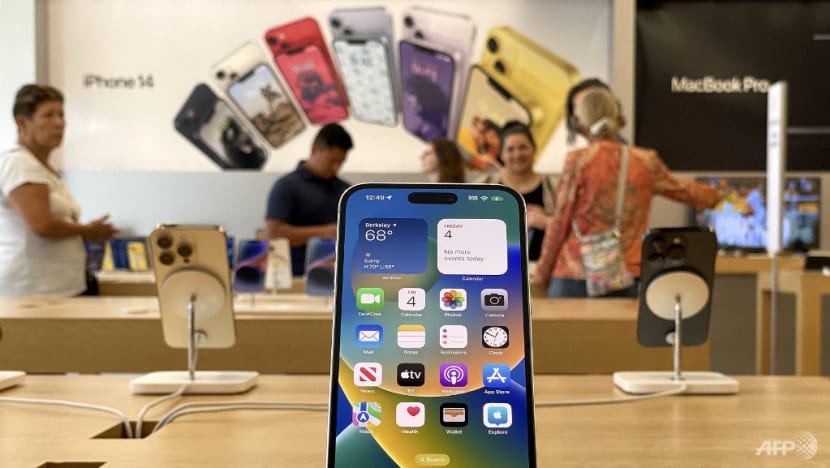Commentary: Apple’s next iPhone needs to be irresistible
Slump in smartphone sales will be tough to reverse unless consumers view the new model as a significant upgrade, says Bloomberg Opinion's Dave Lee.

An Apple iPhone 14 is displayed at an Apple Store on Aug 04, 2023 in Berkeley, California. (Photo: JUSTIN SULLIVAN / GETTY IMAGES NORTH AMERICA / Getty Images via AFP)
SAN FRANCISCO: Apple’s third straight quarter of declining revenue is a symptom of the fact that while people love to use the company’s iPhones, they are these days feeling less pressed to buy a new one. If Apple wants to turn that around, bucking an industry-wide slump, the next iteration of its most popular product needs to be a return to the days when owning the latest iPhone felt like a major upgrade.
For the April to June period, iPhone sales of US$39.7 billion - a 2.4 per cent drop versus the same period last year - came in below analysts’ expectations, as did the iPad, down 20 per cent year-on-year and the Mac line, down 7.3 per cent. Chief financial officer Luca Maestri said device sales in the current quarter weren’t looking too hot, either, blaming foreign currency headwinds and supply chain disruptions.
Another drop in revenue in the July to September quarter would mean the worst run of revenue declines for Apple in two decades. Shares of Apple closed down 4.8 per cent on Friday, dragging Apple’s stock market value below the coveted US$3 trillion level it reached at the end of June.
That is despite overall company revenue being higher than expected due to Apple’s booming services segment - the part of its business that covers subscriptions such as Apple TV+ and Apple Music. For the first time, there were more than 1 billion subscribers to its various offerings, Apple said, pushing up services revenue by 8.2 per cent.
While that was encouraging news for investors - services is Apple’s most profitable segment - what they really care about is the health of the iPhone, which makes up more than half of Apple’s annual revenue. So attention now turns to September, when Apple is set to launch the iPhone 15.
ENCASED IN TITANIUM
Bloomberg News has reported that the device is expected to be the most significant upgrade since Apple added 5G to the phone three years ago.
The new model will make use of a manufacturing technique - “low-injection pressure overmoulding” - that allows for the bezel around the screen to be smaller than ever, getting it close to a truly edge-to-edge display. It will run on a faster chip, and the camera upgrade will be significant. And it will all come encased in titanium, so it will smudge less.
Will that be enough to have people heading out in droves to upgrade? It’s a big ask.
We are in the midst of a broader slump in sales of mobile devices. Earlier this week, Qualcomm, a big maker of smartphone chips, warned of waning demand. “The smartphone industry is tough in the US right now,” acknowledged Apple CEO Tim Cook on Thursday, speaking to CNBC.
Consumers are feeling the pressure of inflation on their everyday spending. That could make a new phone a luxury too far, particularly since the device will be Apple’s most expensive yet. That’s an often overlooked factor. In 2017, when Apple announced that the iPhone X would be a whopping US$999, many wondered whether consumers would turn up their nose at such an expense.
They didn’t, and the phone was a smash hit. Yet while people are prepared to spend that kind of money on a device they use many times a day, one knock-on effect of the higher price point has been a reluctance to upgrade as often. An estimate from analyst firm Wedbush says of the roughly 1.2 billion iPhones out there today, around 230 million haven’t been updated in at least two years.
SHOOTING ITSELF IN THE FOOT WITH LONGER LASTING PHONES
Another reason for this is the quality of Apple’s engineering. In the iPhone’s early days, if you found yourself caught one or two cycles behind, you became acutely aware of it when apps slowed to a crawl. Some didn’t install at all, and your battery would struggle to last even half a day.
Through its own ingenuity, helped by the development of its bespoke chips, Apple has been able to produce a device that has gotten faster and longer lasting. Apple hasn’t removed the frustrations of ageing devices entirely, but it’s clear the reason many people don’t upgrade their phones for years is that they just don’t need to - at least not as often.
The iPhone 15, even with its enhancements, needs to bring a lot to the table if it is to disrupt that pattern.


















